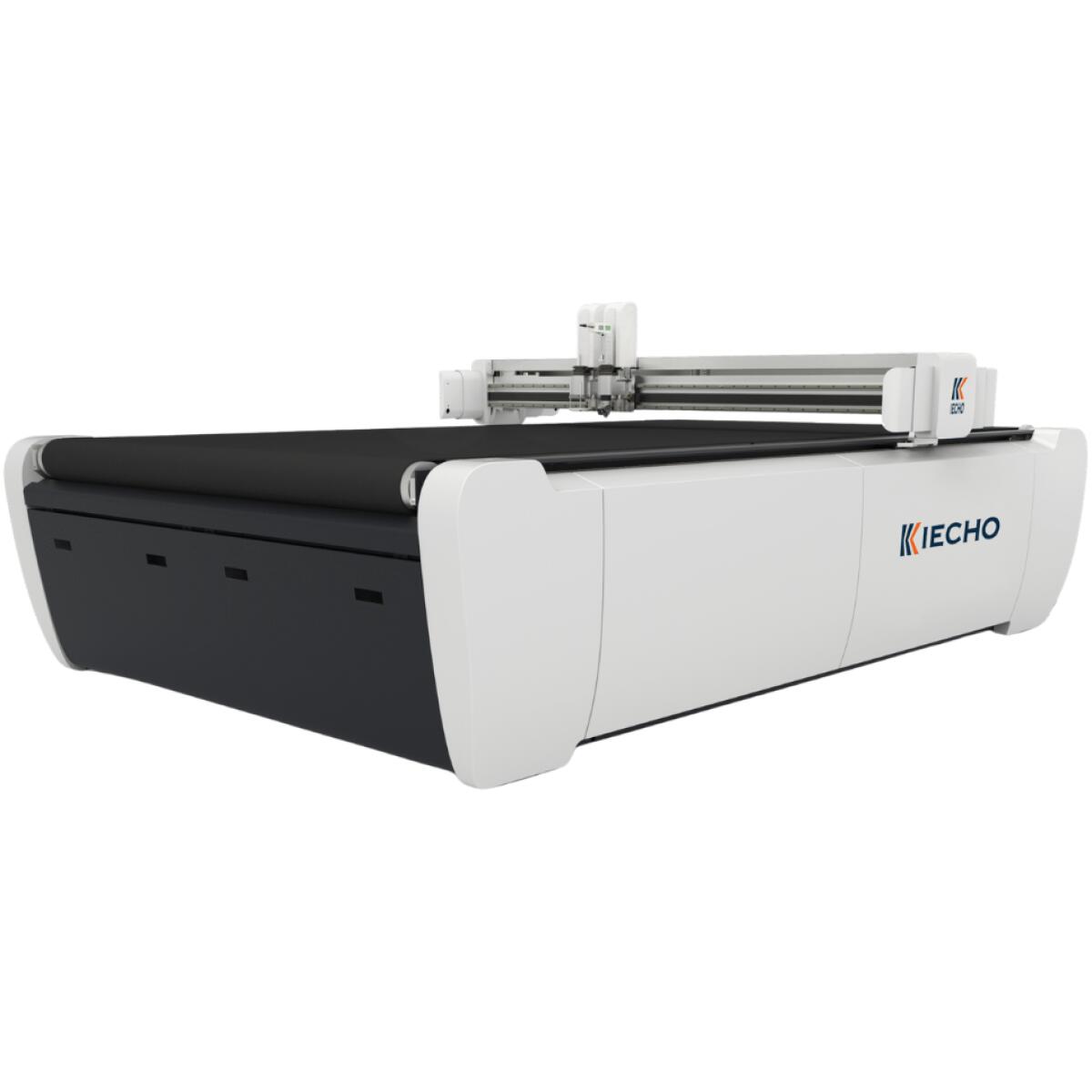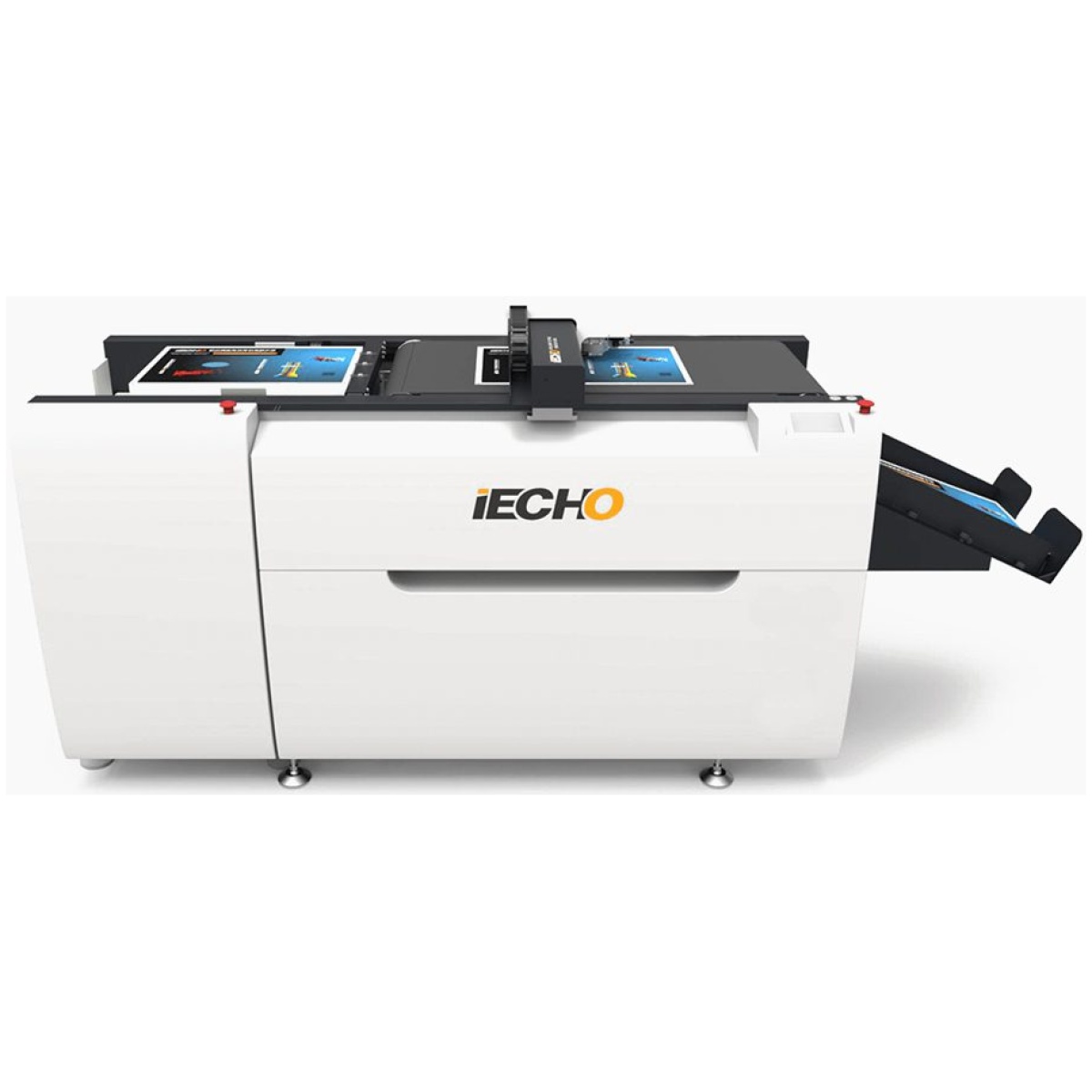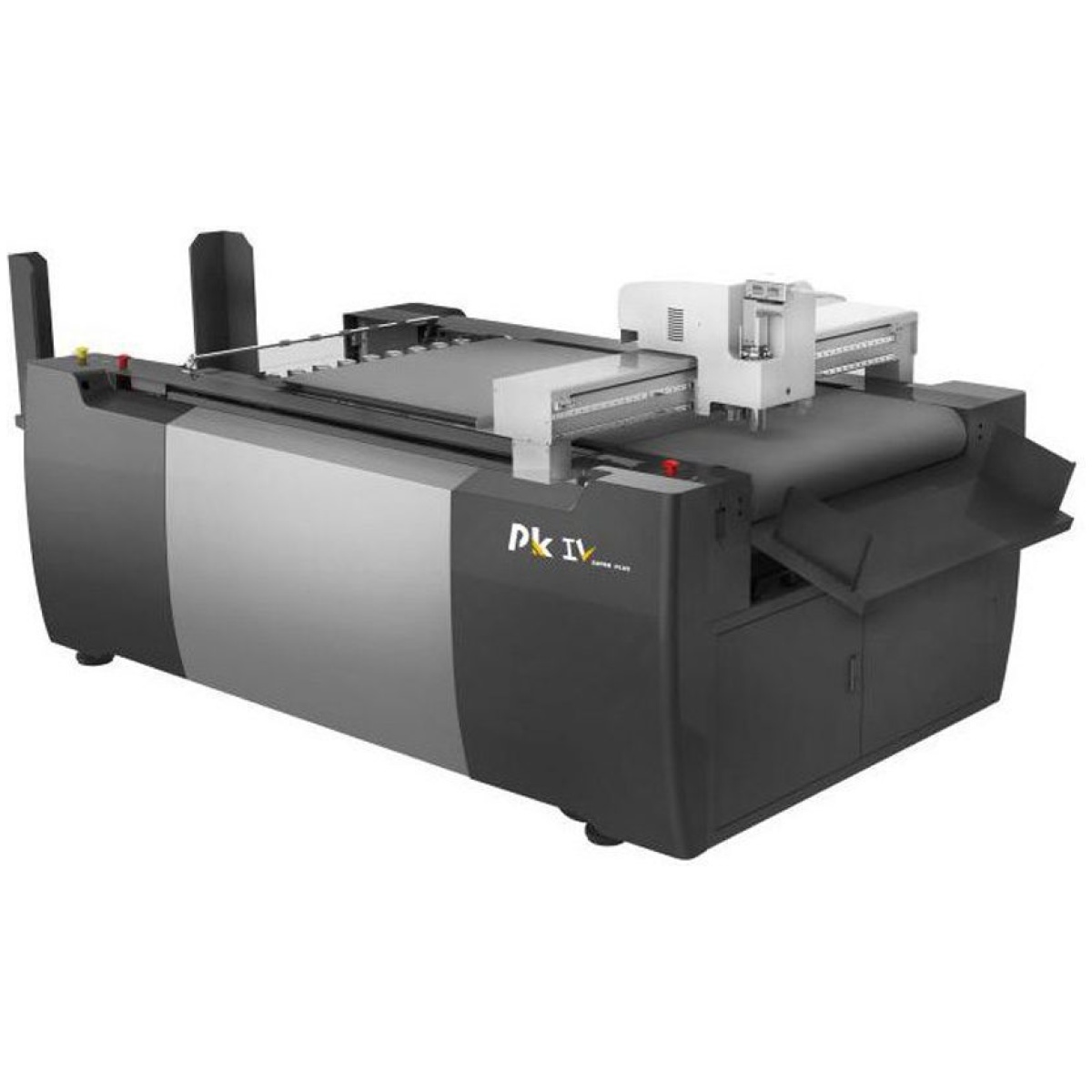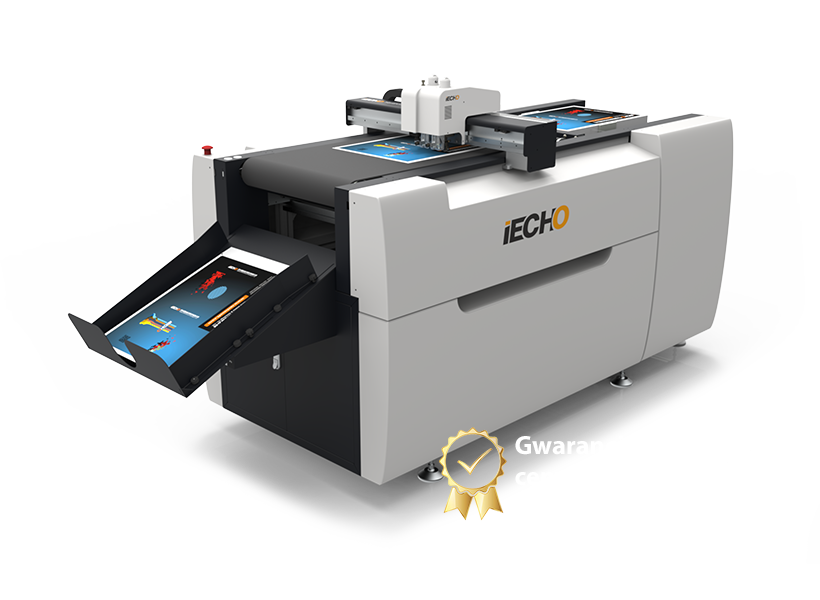Implementing QR code-based sheet processing automation on iEcho PK/TK/BK plotters is a process that can be divided into two main stages: material and file preparation and automated workflow.
Stage 1: Preparation of Materials and Files - Key to Success
Careful preparation is the foundation of smooth and error-free automation. It includes both proper labeling of sheets and proper preparation of project files.
QR on iECHO plotters!
The Role of the QR Code: the Digital Key to Your Order.
At the heart of the entire automation system is the QR code. This small, two-dimensional code, printed on each sheet of material to be processed, contains a key piece of information: file name sewn in, which is to be used to cut a given sheet. The iEcho's plotter control software, such as iBrightCut or CutterServer, is designed to efficiently scan these QR codes and automatic download of relevant cut files saved on a computer or network server.
It is extremely important that the QR code is placed In the same, precisely defined place on each sheet. This is a prerequisite for the plotter's CCD camera to reliably locate and read it. It is recommended to use an appropriate contrast between the code and the background, ensure a minimum size, and leave a so-called quiet zone (empty area) around the code. It is always recommended to carry out QR code scanability tests before launching mass production to avoid problems at a later stage. The code should be 10×10 mm in size and placed in the upper left corner (position definable in the settings) 15 mm from the marker. The precision of the printing and placement of the QR code is crucial here, highlighting the close integration and interdependence of the printing and cutting stages in an automated process.
Defining plotter operations: The magic of line colors in DXF/PDF files
Another key element of preparation is the proper definition of the operations the plotter is to perform on the material. According to the system's assumptions, the individual plotter functions - such as trailing knife cutting, active knife cutting, oscillating knife cutting, creasing or marker reading - are described with a appropriate line colors in design files. The iEcho PK/TK/BK plotter supports popular vector file formats, including. DXF and PDF. Although DXF is recommended.
Software supplied with iEcho plotters, in particular iBrightCut, offers functionality that allows you to define tools and operations based on the line colors contained in the imported file. The available video demonstrates how easy it is to configure in the iBrightCut software automatic Matching the appropriate tool (and thus the operation) to the color of the graphic data:
- First, open the CutterServer software and select the tool to be associated with the color.
- Then, in the iBrightCut software, in the "Settings" menu, and more specifically in the "Default Color" option, select a predefined tool and assign it a specific color from the palette.
- After saving this configuration, when importing subsequent project files, the software will automatically recognize the lines with a defined color and will assign the appropriate tool and processing parameters to them.
It's worth noting that iBrightCut software also has a "Layer Setting" system, which allows designers to divide graphics into individual layers and then assign different cutting methods, tools and order of operations to each layer individually. This gives users choice and flexibility - operations can be defined by line colors, which is often a more direct and faster method, especially for less complex projects, or by layer structure, which can offer more control and organization for complex tasks with many different operations. The choice of method depends on the specifics of the project, the user's preferences and the internal workflow standards of the company. The table below shows the mapping of line colors to iEcho PK plotter functions.
🔧 Cutting tool table
HEX color codes for different types of tools
| Tool code | Color HEX | Color Preview | Name of the tool | Description |
|---|---|---|---|---|
| CCD | #00FFFF | Camera | Camera - video system | |
| DK1 | #FF00FF | Trailing knife 1 | Drag Knife 1 - drag knife | |
| DK2 | #00FF00 | Trailing knife 2 | Drag Knife 2 - a second drag knife | |
| CREASE | #F5CFFB | Bigging | Crease - creasing tool | |
| CUT EOT | #FFFF00 | Oscillation | Cut End of Tool - oscillating cutting | |
| CUT1 | #FF0000 | Active knife | Active Cut - active knife cutting | |
| PRT | #0080FF | Cutting disc | Power Rotary Tool - rotary cutting tool | |
| PTO | #808000 | Pneumatic oscillation | Pneumatic Oscillating Tool | |
| KISSCUT | #FF00FF | Kiss Cut | Superficial cutting - does not cut completely | |
| PEN | #00FF00 | Pen | Pen - drawing/marking tool | |
| MILL | #FF8000 | Milling machine | Milling tool | |
| VCUT | #9257FF | V-cut | V-shaped cutting - grooving |
Stage 2: Automated workflow - iEcho plotter takes command
Once the materials and files are properly prepared, the cutting process on the iEcho plotter becomes fully automated and requires minimal operator intervention.
- Loading Sheets: The operator places the pre-prepared sheets - with the QR codes printed in the same predefined position - on the plotter's automatic feeder. The feeder's capacity allows the material to be loaded for longer runs.
- The Magic of Scanning: Once the cycle starts, the iEcho plotter's built-in CCD camera automatically pulls up over each successive sheet taken from the feeder and scans the QR code on it.
- Automatic Cut File Download: Based on the information read from the QR code (that is, the file name), the control system plotter automatically searches for and downloads the appropriate project file (in DXF or PDF format) from a previously designated folder.
- This folder can be located on the local drive of the computer controlling the plotter or, to greatly increase flexibility, it can be a network folder. The use of a network folder paves the way for centralizing the management of cutting files, allows easy access to files from different production preparation (DTP) stations, and facilitates data backup and archiving. This is an important step toward building a more integrated and efficient production environment.
- Moreover, the network folder can be automatically fed with files by RIP software (Raster Image Processor. Once the rip process is complete and the job is ready for printing (which may include, for example, adding stripers and automatically generating and placing a QR code on the imposition), the RIP software can save the finished cut file directly to a folder monitored by the iEcho plotter PK/TK/BK. RIP software often has workflow automation and job management functions , which fits perfectly with the concept of automated cutting. This integration with the RIP system represents another, higher level of automation. This means that from the moment the file is uploaded for printing, through its automatic preparation and printing (including the QR code), to the final, precise cutting of the product, operator intervention can be reduced to an absolute minimum. This creates a seamless connection between the prepress, press and postpress stages, eliminating the risk of mistakes associated with manual file transfers and ensuring that the correct version of the design is always used for cutting.
- Precise positioning and execution of the order:
- After reading the QR code and downloading the corresponding file, the CCD vision system also uses the cut marks (stripers) printed on the sheet, if they are present in the design. Based on these, the plotter precisely positions the design relative to the actual position of the print on the sheet, compensating for any shifts, stretches or other material deformations that may have occurred during the printing process.
- The iEcho plotter then automatically proceeds with the job, performing all the operations defined in the file (cutting, creasing, notching, marking) according to the pre-configured mapping of line colors to tools and processing parameters. This entire process - from taking the sheet from the feeder, to QR scanning, file downloading, positioning, and final cutting - is fully automatic, without any interaction or clicking by the operator. The combination of an automatic sheet feeder, an intelligent QR code scanning system, automatic cut file retrieval and a precise CCD camera-based positioning system allows the plotter to run for long periods without constant supervision. This is particularly valuable when running a large number of diverse, short production runs, where traditional methods would require constant operator involvement.
Key benefits of implementing QR automation on iEcho PK/TK/BK plotters: more than just cutting
Implementation of QR code-based automation system in iEcho plotters PK/TK/BK brings a number of tangible benefits that go far beyond just streamlining the cutting process. It's a strategic investment that can fundamentally change the way a company operates.
- Drastic reduction in human error:
- Automatic downloading of the cutting file based on the scanned QR code completely eliminates the risk of confusion that could result from the operator manually selecting the wrong file. Each sheet is processed exactly according to its assigned design.
- The system also minimizes errors resulting from incorrectly setting the cutting parameters for a given job, as these parameters are closely linked to the project file identified by the QR code.
- Precision CCD vision system of iEcho plotters PK/TK/BK guarantees accuracy on every job, automatically compensating for printing imperfections.
- A quantum leap in performance and throughput:
- Full process automation, from loading to finished product, allows the machine to run continuously, even when handling many different consecutive orders. This reduces downtime and maximizes the use of plotter time.
- Machine changeover time between jobs is significantly reduced - a job change is basically reduced to loading new sheets with new QR codes onto the feeder.
- As highlighted, the 6-axis motion control system on the iEcho plotters PK/TK/BK contributes to a significant acceleration of material processing with minimal or no operator intervention.
- Optimize operator performance and reduce labor costs:
- Automation significantly reduces the operator's involvement in the direct operation of the plotter. Instead of overseeing every movement of the machine, the operator can focus during this time on preparing further orders, operating other production equipment or performing other higher-value-added tasks.
- As a result, one experienced operator can effectively supervise the operation of several automated machines, leading to optimization of human resources and reduction of labor costs.
- Unparalleled production flexibility:
- The QR automation system is an ideal solution for today's market requirements, such as short-run production, realization of personalized work, rapid prototyping and handling on-demand orders.
- The plotter can switch seamlessly between processing different materials and realizing completely different designs without the need for long and complicated changeovers.
- Save materials and increase profitability:
- Precision cutting, aided by a CCD vision system, and the elimination of human error lead to a significant reduction in material waste. Each sheet is used optimally.
- More efficient use of machine and personnel time, combined with a reduction in material wastage, translates directly into lower unit production costs and, consequently, into increased profitability of orders in progress. Although directly applicable to imposition, the principle of optimization and waste reduction is universal and applies here as well.
Implementation of QR code-based automation in iEcho plotters PK/TK/BK is not just an operational improvement at the level of a single machine. It's a strategic investment that allows printing and packaging companies to respond faster and more efficiently to rapidly changing market needs. It makes it possible to handle more diverse, complex and personalized orders, which today is key to building a sustainable competitive advantage. It is a shift from reactive production management, based on putting out fires and dealing with bottlenecks, to proactively shaping processes that are optimized for flexibility, speed and flawlessness.
Start automation with Akonda.co.uk: your path to more efficient and smarter production
In summary, technology iEcho cutting plotters PK/TK/BK, enriched with an intelligent automation system based on QR codes and advanced capabilities for defining operations with line colors in design files , provides a comprehensive answer to today's production needs in the printing and packaging industry. It's a solution that allows you to not only meet today's challenges, but also prepare your company for the future.
Akonda.pl - your partner on the road to automationAkonda.pl is more than just a machine supplier. It is an experienced partner who for years has been supplying Polish printers and printing plants the most modern, proven and reliable technologies. By choosing to cooperate with Akonda.pl, you not only gain access to innovative iEcho plotters PK/TK/BKbut also comprehensive support at every stage - from professional consulting and assistance in choosing the optimal equipment configuration, through its implementation and staff training, to reliable warranty and post-warranty service. An individual approach to the customer and understanding of his specific needs are the foundations of Akonda.pl's philosophy.

